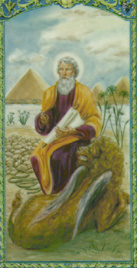The candy cane's humble origins: Do YOU know the sweet treat's story?
FREE Catholic Classes
As soon as Thanksgiving is over, pine trees are erected and decorated, festive music can be heard, Christmas presents are purchased and wrapped and iconic holiday candies are released from their summertime hibernation.
 Hi readers, it seems you use Catholic Online a lot; that's great! It's a little awkward to ask, but we need your help. If you have already donated, we sincerely thank you. We're not salespeople, but we depend on donations averaging $14.76 and fewer than 1% of readers give. If you donate just $5.00, the price of your coffee, Catholic Online School could keep thriving. Thank you. Help Now >
Hi readers, it seems you use Catholic Online a lot; that's great! It's a little awkward to ask, but we need your help. If you have already donated, we sincerely thank you. We're not salespeople, but we depend on donations averaging $14.76 and fewer than 1% of readers give. If you donate just $5.00, the price of your coffee, Catholic Online School could keep thriving. Thank you. Help Now >
Highlights
Catholic Online (https://www.catholic.org)
12/25/2015 (8 years ago)
Published in Home & Food
Keywords: Candy cane, Christmas, Jesus, staff, God
LOS ANGELES, CA (Catholic Online) - Every December brings with it "We wish you a Merry Christmas" Hershey's commercials, peppermint flavored everything, egg nog and of course, several colorful and flavorful candy canes!
Though these days candy canes can be found in a multitude of colors, did you know the original candy canes were pure white?
Legend has it a choirmaster at Cologne Cathedral created the sugary treat to help keep children quiet during church.With a little help from a candy maker, a hook was added to the top of the stick to better resemble a shepherd's staff -specifically the Shepard who paid infant Jesus a visit.
The white of the cane was meant to symbolize the Christ child's purity. The candy cane's popularity spread far and wide, and as it's meaning was based in Christ's birth, it eventually became associated with Christmastime.Many believe today's candy canes can either resemble a shepherd's staff or, when turned upside-down, the letter "J," for "Jesus."
The addition of the red stripe has led many to believe the significance of the humble candy cane serves as an excellent representation of God's gift to us all -His one and only son.
The red is believed to represent the blood Christ shed on the cross. Combined, one can say the candy cane is a letter "j" representing the sacrifice of an innocent, or a shepherd's staff highlighting the birth of an innocent who eventually grew to become the world's Savior through crucifixion.
No matter which way you want to view it, the candy cane's origin is rooted in Christianity, so spread the word and don't forget to hang a few of these delicious candies on your Christmas tree this year!
---
'Help Give every Student and Teacher FREE resources for a world-class Moral Catholic Education'
Copyright 2021 - Distributed by Catholic Online







 Daily Readings for Thursday, April 25, 2024
Daily Readings for Thursday, April 25, 2024 St. Mark: Saint of the Day for Thursday, April 25, 2024
St. Mark: Saint of the Day for Thursday, April 25, 2024 Prayer for Policemen: Prayer of the Day for Thursday, April 25, 2024
Prayer for Policemen: Prayer of the Day for Thursday, April 25, 2024


